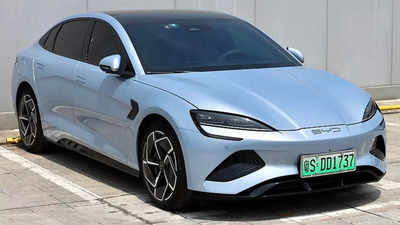Trending
Chinese EV maker BYD surpasses Tesla in revenue, challenging Elon Musk’s dominance
China's BYD surpasses Tesla in 2024 annual revenue, reporting $107 billion, driven by strong domestic demand and global expansion. BYD's affordable high-quality EVs and a breakthrough charging system threaten Tesla's market position. As Tesla contends with declining demand and competition, BYD's success highlights potential shifts in the EV industry landscape, particularly if US trade barriers fall.
The global electric vehicle (EV) market is witnessing a significant shift as China’s BYD (Build Your Dreams) overtakes Tesla in annual revenue for the first time. BYD reported a staggering $107 billion in revenue for 2024, surpassing Tesla’s figures by approximately $10 billion. This milestone underscores BYD’s rapid expansion in China, the world’s largest automobile market, and its increasing global presence.
The competition between Tesla and BYD has intensified as the latter continues to introduce advanced EV technologies and expand its market share. While Tesla remains dominant in the US market due to trade restrictions on Chinese imports, BYD’s growing success in other regions presents a serious challenge to Elon Musk’s company.
BYD’s record-breaking growth surpasses Tesla in revenue, reshapes the global EV market
BYD’s impressive financial results for 2024 mark a significant milestone in the EV industry. The company’s revenue surge is fueled by strong domestic demand in China, where it has established itself as the leading EV manufacturer. Additionally, BYD has been expanding aggressively into global markets, excluding the United States due to trade barriers. As per reports, the company’s Hong Kong-listed shares have risen by more than 50% this year, reflecting investor confidence in its growth trajectory.
BYD’s new charging tech outpaces Tesla, adding 250 miles in 5 minutes
A recent breakthrough further solidified BYD’s competitive edge. The company unveiled a cutting-edge charging system that allows its latest EV models to gain 250 miles of range with just a five-minute charge. This advancement is a game-changer for the EV industry, addressing one of the primary concerns among consumers—charging time.
Tesla, on the other hand, continues to invest in its Supercharger network but has yet to introduce a charging solution that matches BYD’s latest innovation. As charging speed becomes a crucial factor in EV adoption, BYD’s latest technological leap may influence consumer preferences in key markets.
Tesla’s market struggles and investor concerns
While BYD continues its upward trajectory, Tesla is facing increasing challenges. The company’s stock has been in decline for nine consecutive weeks, with investors citing several concerns, including:
- Declining demand in key markets – Tesla’s European sales fell by 44% in February 2024, while Chinese brands experienced an 82% increase in the region.
- Increasing competition – Tesla is no longer the only dominant force in the EV industry, with multiple Chinese automakers, including BYD, gaining ground.
- Brand perception issues – Tesla’s association with political controversies and CEO Elon Musk’s outspoken public persona have impacted its reputation among certain consumer segments.
Additionally, used Tesla prices have been dropping, even as interest in second-hand EVs rises, signaling shifting consumer demand.
Tesla Holds US EV lead, But BYD looms if trade barriers fall
Despite BYD’s global rise, Tesla continues to lead the US EV market, thanks in large part to trade restrictions that prevent Chinese automakers from entering the space. Tariffs imposed on Chinese imports protect domestic manufacturers, giving Tesla a crucial advantage in the American market.
However, the future remains uncertain. If trade policies were to shift, BYD could potentially enter the US market, intensifying competition and challenging Tesla’s dominance. Analysts speculate that Tesla may need to introduce lower-priced models to remain competitive, a strategy already in development with a rumored smaller, more affordable Model Y expected to launch in 2026.
Discover everything about the automotive world at Times of India.
End of Article
FOLLOW US ON SOCIAL MEDIA










